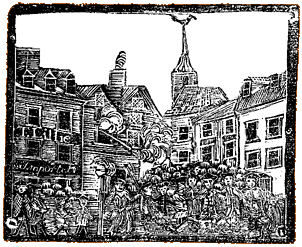“A Monument over the grave of young SEIDER”?
On 5 Mar 1770, the Boston Gazette reported on the grand funeral for little Christopher Seider, shot by Ebenezer Richardson on 22 February, and added:
That presents a political mystery. The “Gentleman who had a considerable share in the popular transactions of the year past” had to be one of Boston’s Whigs. But Sewall was a friend and vocal supporter of the royal government. Would the same newspaper writer attack both sides?
One possible explanation is that the Trifler supported the Crown but resented how Sewall was hogging two lucrative government appointments: Massachusetts Attorney General and Judge of the Vice Admiralty Court. Several letters and even newspaper reports from that period show how royal officials wanted Sewall to hand over the judgeship to Customs Commissioner John Robinson. (In the end, Sewall clung to both jobs.)
So who was the “Gentleman who had a considerable share in the popular transactions of the year past”? I think the most likely candidate is William Molineux. He was definitely the Whigs’ leader in street demonstrations. He was close to Madam Grizzell Apthorp, who had employed Christopher Seider as a house servant, and he was on the scene when people arrested Richardson.
Molineux was also in need of money. On 1 May 1771 he was supposed to repay the town of Boston £300 it had loaned him to kickstart a cloth-weaving enterprise that would employ the poor. He never did pay that back. By 1774 Molineux had probably applied money he was supposed to manage for Charles Ward Apthorp of New York to the weaving scheme. So it’s not hard to imagine that the funds collected for a monument to Christopher Seider went into the same hole.
Then again, the first report from 1770 said merely that some gentlemen had “generously subscrib’d” or promised money for a monument. The Trifler may have been wrong to say that funds had actually been collected. After all, in the evening after the Gazette reported on the possibility of a monument, the Boston Massacre took place. Suddenly everyone had something new to focus on and argue about.
We can assure the Publick, that a Monument will be erected over the Grave of young Snider, with an Inscription, to perpetuate his Memory; A Number of patriotic Gentlemen having generously subscrib’d for that Purpose——It is said it will be done in an elegant Simplicity, and that the Overplus Money, if any, will be given to the Parents.However, over a year later the 21 Mar 1771 Massachusetts Spy ran this item on the same matter:
For the MASSACHUSETTS SPY.The Spy had published another item signed “The TRIFLER” on 10 January. It was a snide attack on Jonathan Sewall, identified by his own newspaper pseudonym “Philanthrop.” It said he should be “satisfied with his 600l. sterling per annum, and no longer prostitute his pen.”
Mr. [Isaiah] THOMAS,
As there was a collection made some time ago by a Gentleman who had a considerable share in the popular transactions of the year past, for the professed purpose of erecting a Monument over the grave of young SEIDER; if the above Gentleman will condescend to inform the Public, why the Money so collected, has not been approproiate to the avowed design, he will oblige a number of your readers, as well as your humble servant,
The TRIFLER.
That presents a political mystery. The “Gentleman who had a considerable share in the popular transactions of the year past” had to be one of Boston’s Whigs. But Sewall was a friend and vocal supporter of the royal government. Would the same newspaper writer attack both sides?
One possible explanation is that the Trifler supported the Crown but resented how Sewall was hogging two lucrative government appointments: Massachusetts Attorney General and Judge of the Vice Admiralty Court. Several letters and even newspaper reports from that period show how royal officials wanted Sewall to hand over the judgeship to Customs Commissioner John Robinson. (In the end, Sewall clung to both jobs.)
So who was the “Gentleman who had a considerable share in the popular transactions of the year past”? I think the most likely candidate is William Molineux. He was definitely the Whigs’ leader in street demonstrations. He was close to Madam Grizzell Apthorp, who had employed Christopher Seider as a house servant, and he was on the scene when people arrested Richardson.
Molineux was also in need of money. On 1 May 1771 he was supposed to repay the town of Boston £300 it had loaned him to kickstart a cloth-weaving enterprise that would employ the poor. He never did pay that back. By 1774 Molineux had probably applied money he was supposed to manage for Charles Ward Apthorp of New York to the weaving scheme. So it’s not hard to imagine that the funds collected for a monument to Christopher Seider went into the same hole.
Then again, the first report from 1770 said merely that some gentlemen had “generously subscrib’d” or promised money for a monument. The Trifler may have been wrong to say that funds had actually been collected. After all, in the evening after the Gazette reported on the possibility of a monument, the Boston Massacre took place. Suddenly everyone had something new to focus on and argue about.


No comments:
Post a Comment